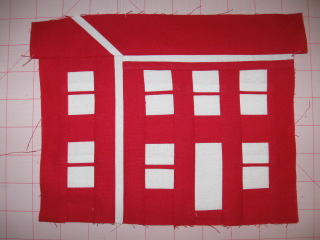The original quilt was on display in New York the last week of March as part of the show at The American Folk Art Museum. The original was made around 1910. I have made 2 of these, working on another.
Feel free to contact me with any questions.
Overview
Size: 84 x 84
Yardage: 7 yds red
7 1/2 yds white
1 yd less of each fabric is needed if you choose to cut in the thrifty method described later.
Read ahead in the instructions and you will get an understanding of how this will go together.
This quilt is strip pieced, goes together much quicker than it looks. Strip sets are made with graduating sizes of strips. Narrow wedges are cut from the strip sets and sewn to form the bullseye center. I learned a few hints along the way that I will share. There are 52 wedges, 21 strips in each wedge. Dividing a circle into 52 wedges gives an odd angle, one wonders why that number was chosen. 52 weeks in the year? 52 cards in a deck?
There are 2 kinds of strip sets. One starts and ends with red, the other starts and ends with white.
The cutting of wedges leaves a lot of waste scraps. You can not just flip your wedge template upside down and cut the next wedge the other direction because you would end up with the wrong size red and white pieces in the wrong order. To save fabric, I give directions to cut the wedges in parts then sew them together. That will save about 1 1/2 yards of each fabric. It is not a great lot of extra sewing, but you may choose to just cut the entire wedge from a whole strip set. You may have ideas to use up the scrap.
I used a white bed sheet (don't call the quilt police!). A wide sheet can be split in half and used like yardage. I did this because I felt it would give a bit of sheen and would be durable. I machine quilted, so that was not a problem. I had no problem doing needle turn applique on the sheet fabric. Also a sheet was inexpensive.
Cutting strips
Tip: Store the cut strips in the pages of a note book or a road atlas to keep from getting them mixed up. All of one "row" in each page.
If you plan to cut whole wedges all at once, you will need to make 3 full and one half strip sets of both kinds (begining and ending in red, and begining and ending in white).
So, for each row cut 3 red strips and 3 white strips. Place them for safe keeping between the pages of a note book, one row (3 red, 3 white) in each page. Then cut a 25" length of each fabric. Cut each in half along the fold giving you 25" by (approximately) 22". Cut a set of each color from these, (half as wide as the other strips).
Be careful to cut along the (+ or -) 22" edges, or you will run out before all are cut. Keep these half strips in the same page as the full strips of the same width.
OR,
If you want to save a bit of fabric, cut one strip of each color rows 1 thru 9.
Cut 2 full strips and 1 half strip of each color rows 10 thru 17.
Cut 3 full and 1 half strip of each color rows 18 thru 21.
To get the half strips, cut a 20" length of each fabric. Cut in half along the fold. You have 20" x (about) 22" pieces. Cut half strips for rows 10 thru 21 from these pieces, cutting along the 22" edge. 1 red and 1 white for each row.
Cut strips in these widths:
row width
1 2"
2 1"
3 1"
4 1 1/8"
5 1 1/8"
6 1 1/4"
7 1 3/8"
8 1 3/8"
9 1 1/2"
10 1 5/8"
11 1 3/4"
12 2"
13 2 1/8"
14 2 3/8"
15 2 1/2"
16 2 3/4"
17 3"
18 3 3/8"
19 3 3/4"
20 4 1/8"
21 4 5/8"
Making strip sets
Sew with close stitches, these wedges are cut narrow at the end and stitching can come undone.
Be carefull on the first few rows not to get the order of rows mixed up. It is easy after about row 8 to start sewing on the wrong edge (row 1).
If you are going to cut whole wedges, make strips sets with all rows 1 thru 21. 3 full width sets and a half width set will start and end in red. 3 full width sets and a half width set will start and end in white. Press to the red.
If you are making the wedges in sections:
Use rows 1 thru 9 to make a strip set starting and ending in white, and one strip set starting and ending in red.
Use rows 10 thru 17 to make 2 strip sets starting and ending in white and 2 strip sets starting and ending in red.
Press to the red.
In this photo the strip sets for rows 1 thr 9 and 10 thr 17 are done. Rows 18 thru 21 are still in the pages of the road atlas. The wedge template is also shown.
Comming soon, I will show how to make the template.



























